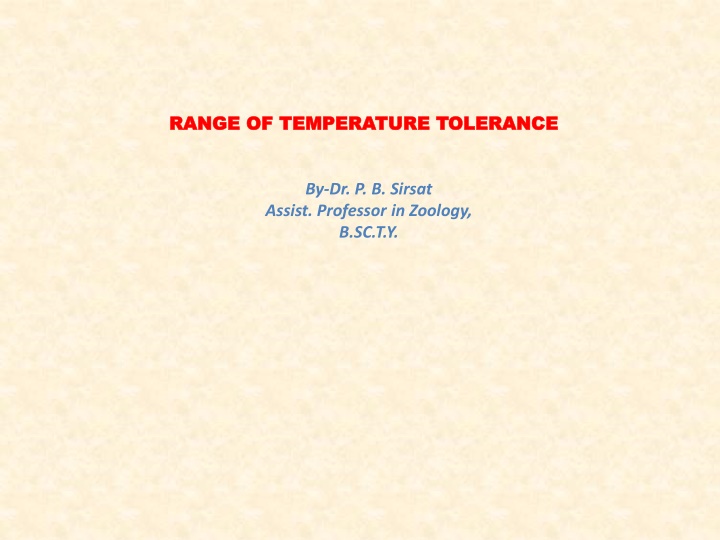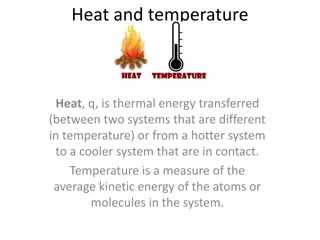Temperature Tolerance of Organisms in the Universe
Life on Earth exists within a range of temperatures, with organisms displaying varied temperature tolerance. Eurythermal organisms can withstand large temperature fluctuations, while stenothermal organisms tolerate only small variations. The temperature range for each species is crucial for their physiological activities, with metabolic processes starting at a minimum temperature and increasing as the temperature rises. Understanding temperature tolerance is essential for studying the distribution and survival of different species.
Download Presentation

Please find below an Image/Link to download the presentation.
The content on the website is provided AS IS for your information and personal use only. It may not be sold, licensed, or shared on other websites without obtaining consent from the author.If you encounter any issues during the download, it is possible that the publisher has removed the file from their server.
You are allowed to download the files provided on this website for personal or commercial use, subject to the condition that they are used lawfully. All files are the property of their respective owners.
The content on the website is provided AS IS for your information and personal use only. It may not be sold, licensed, or shared on other websites without obtaining consent from the author.
E N D
Presentation Transcript
RANGE RANGE OF TEMPERATURE TOLERANCE OF TEMPERATURE TOLERANCE By-Dr. P. B. Sirsat Assist. Professor in Zoology, B.SC.T.Y.
RANGE OF TEMPERATURE RANGE OF TEMPERATURE TOLERANCE TOLERANCE Life in this universe exists within a range of - 200 to 1000c. Normal life persists within narrow temperature limits of about -10 to +500c. Many nematodes, rotifers & tardigrades have shown to with stand cooling to-2720c with out ill effect . Some algae & Bacteria are reported to live in the hot spring at 800c.at temperatures greater than 900c (BOTT & BROCK, 1969).
The organisms (Microbes, Plants & Animals) which can tolerate very large fluctuations in temperature are called as eurythermal organisms. For example, Cyclops, toads,toad,wall lizards, grass snakes, man, etc., are eurythermal animals.
The organisms which can tolerate only a small variation in temperature are termed as stenothermal organisms. The organisms which can tolerate only a small variation in temperature are termed as stenothermal organisms.
The common stenothermal organisms are fishes,snails,coral reefs,etc. In organisms all metabolic processes necessary for life start at a certain minimum temperature & increase with rise in temperature
until they reach the maximum temperature called as maximum temperature called as optimum temperature. The temperature range for any particular species is determined by the prevailing temperature of which normal physiological activities of the animals take place, as in distribution of the rotifer keratella procura (Nayer, 1970).
This rotifer species is known to appear in the ponds of pilani, Rajasthan (India). If the temperature is below 240c & to disappear when it rises above 240c. The frequency of distribution reaching a peak during months October to March, with the fall in temperature.






















